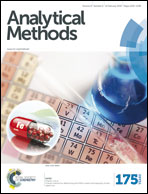An aptasensor based on fluorescence resonance energy transfer for multiplexed pathogenic bacteria determination†
Abstract
Techniques that are simple and suitable for the identification of multiple pathogenic bacteria are vital to ensure food safety. There has been a critical demand for techniques that can recognize numerous bacterial pathogens simultaneously in a single assay. In this work, a multiplexed assay on an aptamer-based platform is presented using multicolor dyes as donors and carbon nanoparticles (CNPs) as a sole acceptor in fluorescence resonance energy transfer (FRET) for simultaneous detection of multiple bacteria. Multicolor fluorescent probes, fluorescein amidite (FAM)-apt 1, cyanine dye 3 (Cy3)-apt 2 and 6-carboxy-X-rhodamine (ROX)-apt 3 were used for recognizing specific targets, which bound to the surface of CNPs through π–π stacking interactions. As a result, the energy donors and acceptor were taken into close proximity, leading to the quenching of the fluorescence of the multicolor dyes. In the presence of three bacteria, V. parahaemolyticus, S. aureus, and S. typhimurium, the aptamers preferred to bind to their corresponding pathogens, which led to changes in the formation of the aptamers, and thus, the aptamer-labeled dye dissociated from the CNP surface. The restored fluorescence intensity of FAM, Cy3 and ROX was related to the concentration of the three bacteria. The applicability of the bioassay in real food samples was also investigated, and the results were consistent with the experimental results obtained from plate-counting methods.


 Please wait while we load your content...
Please wait while we load your content...